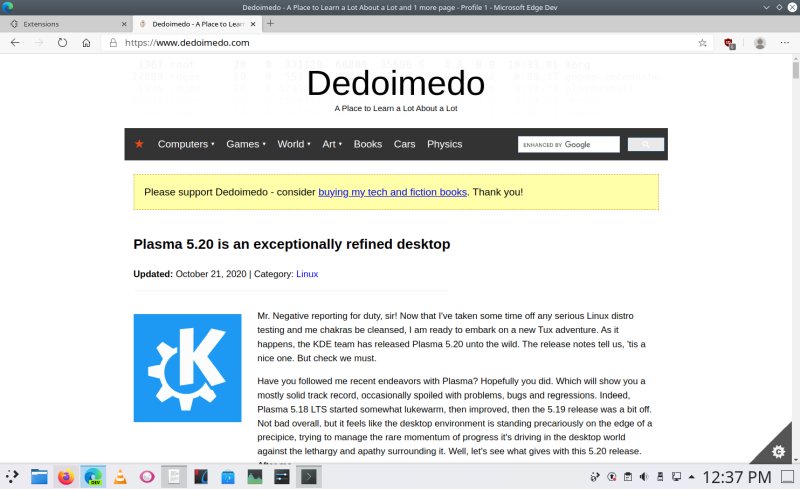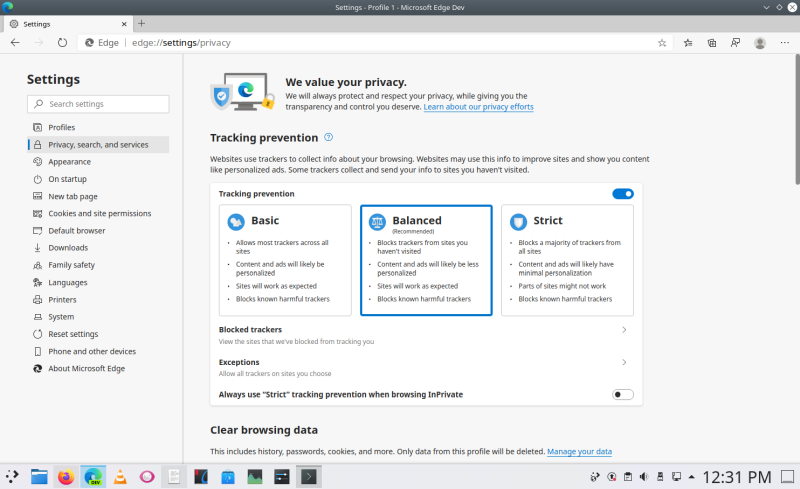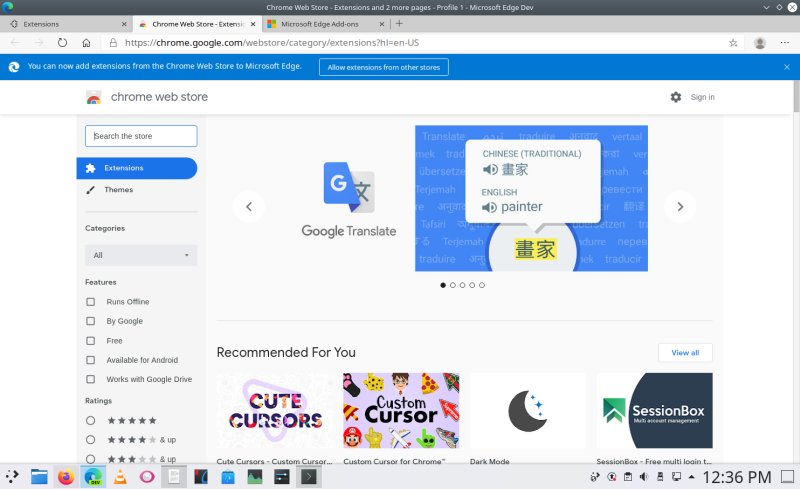Updated: November 2, 2020
What the world needs are more browsers. What the world does not need are more Chromium-based browsers. It's like that scene from the movie I Love You, Man, where a work colleague sends Paul Rudd's character a rather non-work clip: I don't want it. You've got it! There. As it happens, the world has a new Chromium-based browser, and now Linux has it, too. We're talking about Microsoft Edge.
In a way, Edge is the culmination of the Internet Explorer 6.0 story, told over ~15 years or so. It's also an interesting turn of events, because for the first time, there is an official (well, almost) version of a Microsoft browser available for Linux. No more WINE or whatnot tricks, you run this as is. Well, I wanted to see how good or useful or relevant this browser is. And I'm not going to focus on the shock value of OMG, Microsoft software running on Linux. That's overdone. So with that in mind, we check, yegdemash.

Setup
I decided to try the preview build on my KDE neon 5.20 instance. If you follow the official instructions, there's also the signing key thingie, plus you will get updates. At the time, I didn't, I just grabbed the .deb file, and tried to install it through Discover, and this didn't work. I then ran the installation on the command line, using dpkg, and this did work, but the setup failed as a font package was missing. Once I sorted that out, Edge was installed and working correctly. Well, this was my fault really.
dpkg: dependency problems prevent configuration of microsoft-edge-dev:
microsoft-edge-dev depends on fonts-liberation; however:
Package fonts-liberation is not installed.
The interesting thing that happened was - the Firefox icon disappeared from the icons-only manager, it got unpinned. Instead, Edge was pinned there. Odd. However, Firefox remain(ed) the default browser, and Edge actually couldn't check whether it was the default application or not. Well, no biggie really.
You need to accept the terms so to speak - before the browser opens - including optional diagnostics. You can also choose the layout you want for the New Tab page. Several presets are available, of which Focused looks the most reasonable. Not sure what gives with the scrollbars in the early setup stage, but later on, everything was fine.



Once this initial setup was complete, the browser lay open before me. Feels a bit bland, but then most modern browsers do. What I don't like is the search bar, plus links to a seemingly random collection of sites. But then you can turn most of this off.


Settings, Privacy
Before using the browser, one must go through every option and tweak EVERYTHING. After all, the defaults are almost always designed for low-IQ crowds, so there. Privacy will obviously be a huge deal. Now, as it happens, Edge's configuration ain't bad. Suggestions from Pintrest in Collections are off - not sure what makes this service special, but hey. Then, you can of course minimize the cloud chatter if you toggle off a further bunch of other suggestions and such. However, you cannot disable necessary telemetry [sic].



Under Appearance, you can do quite some, including reducing the amount of noise shown on the New Tab page. But like the other browsers of the Chromium persuasion, it won't let you remove the search bar. At least the about:blank page is what it says. But nothing beats Firefox customizability.


What I found interesting is the Family section, which I don't recall seeing in other browsers - I might just be so used to them that I have familiarity blindness. Familiarity, get it! This lets you tweak your browser behavior so you get a bit more control over unruly offspring or some such. Now, what I didn't like is the option that lets background apps run when the browser is closed. No, that's nonsense, and it's also there in Chrome. If I close the browser, I want all network connectivity severed. Very simple.


Another strong point is the integration with Microsoft services (apps), the whole cloud Office 365 thing. Of course, this is unto Edge what the Google suite of apps is into Chrome. Since a large number of Windows users do run Microsoft software, this may come handy should they dual-boot or end up running Edge on Linux.

Extensions
This is a rather interesting one. One of the big problems with the original IE series was the lack of meaningful, powerful add-ons framework. The original Edge sort of had it, but it was somewhat cumbersome, and you had to go to the Store and follow half a dozen prompts to install extensions. Here, you get the classic browser functionality. And then some.
First, you can use extensions available in the Edge Add-ons Store. But if you find that insufficient, you can also grab extensions from the Chrome Web Store. You will need to allow support for third-party stores. In my test, this was necessary because the default store had no privacy or security extensions whatsoever. None. And if you want to use the Internet, which is nothing more than a cesspool of misinformation and shock value today, then you must use an adblocker at least.

So I went to the Chrome Web Store and grabbed Ublock Origin from there. No fuss. Installed fine.


Now, one can browse, somewhat sanely.
Browsing
All in all, Edge does the job. It's almost identical to Chrome/Chromium. You won't notice any cardinal differences, speed or rendering wise. The interface is similar to its parent product, which I find too restricting. But then, if you are already using Chromium, then you might like this for some other reasons. Maybe. I'm sure a lot of people will only care about acronyms and buzzwords like 4K, UHD, PiP, and such. Well, whatever.


Something I found a little odd - after a system reboot, Edge didn't remember my history. From what I see, the browser was configured correctly. But then, remember, this is a preview build. So. All in all, though, the experience quite tame.
Various features, options
One of the things that Edge offers is immersive reader. Most browsers have this - I've never found this useful, and they call it by different names. Here, you get a laid back reader mode with a colorful range of font options, grammar tools, and more. Quite handy, but again, I fail to see how this would be practical. If the idea is to allow you to read "distracting" sites - the answer is, don't read "distracting" sites. Don't support low-quality stuff by using an alternative view mode, go to sites that offer a pleasant reading experience to begin with. In fact, in the example below, Wikipedia is far more readable in its normal guise than this.

Conclusion
Microsoft Edge is not a bad browser. Far from it, it's quite decent. The only question is, why would you want it? Well, the answer seems to be: who do you trust or prefer - Microsoft or Google? That's about it. There are some differences in settings and options, but only nerds will really care about this, especially on Linux. On Windows, the market domination story is different, and it's about real competition on who gets the major share of the pie.
So the way I see it, if you want a Chromium-based browser to be your default, then simply take your pick among the different options, based on whatever criteria you like. In this regard, Edge isn't any better or worse on any fundamental level. That said, I still believe you should use Firefox, because without it, the future net will be a hundred times worse than it is today, quite likely unusable unless you have the IQ of a spud. So then, the question is, what ought to be your secondary browser? Edge has some decent points, configurable settings, and some extra integration with Microsoft's tooling - the same way Chrome has extra integration with Google's tooling. Your choice. And we're done here.
Cheers.